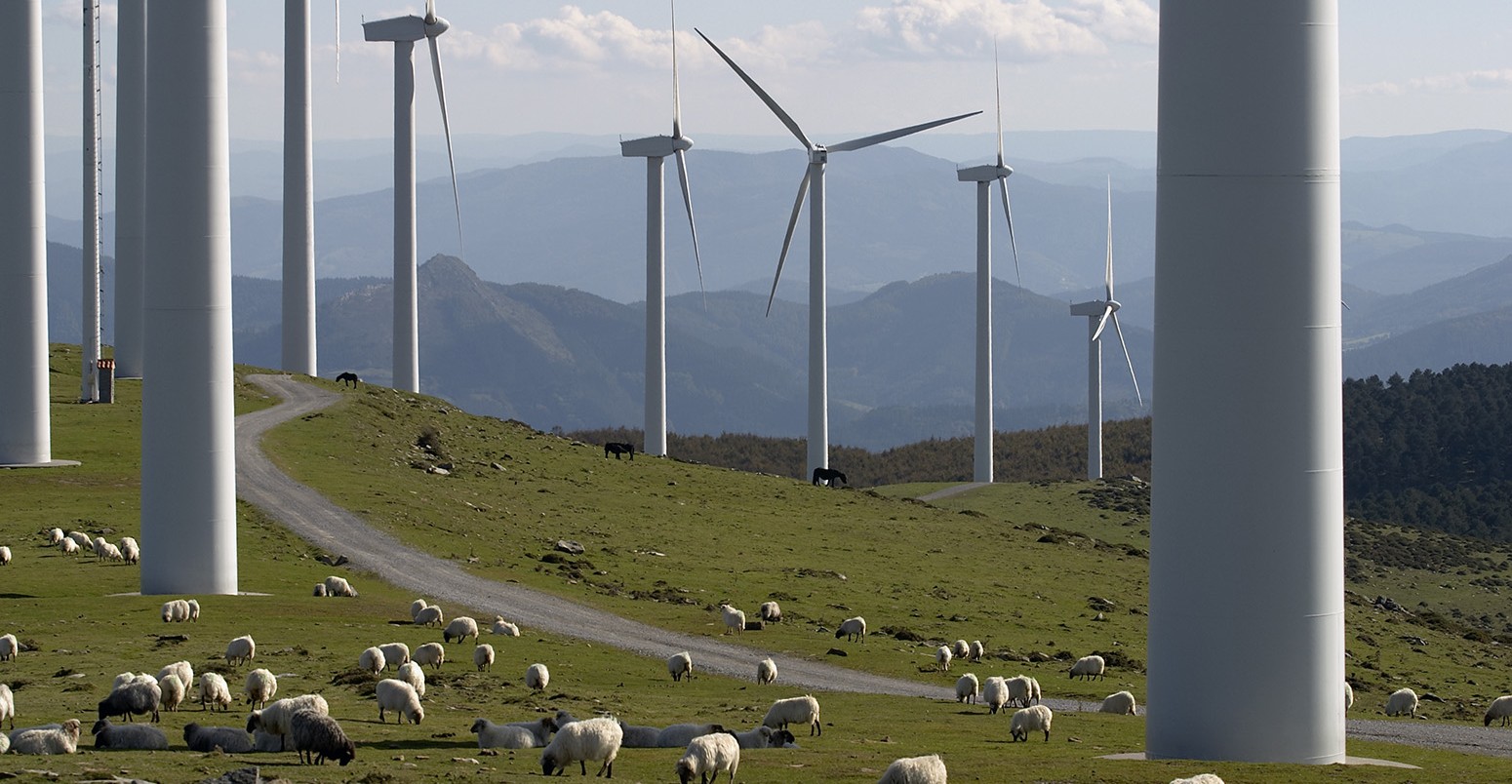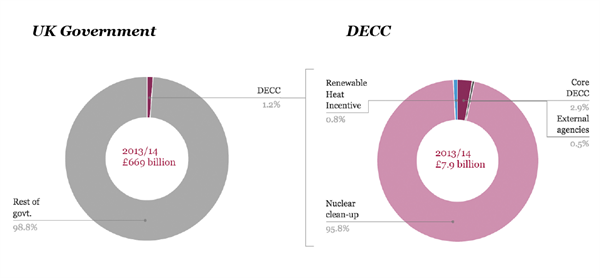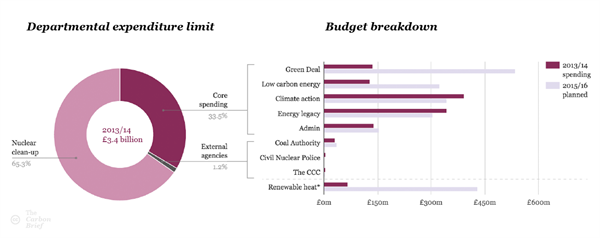
- Update 4/6 – We have published further analysis of DECC’s budget based on a breakdown released to Carbon Brief under Freedom of Information rules. You can read it here.
- Update 16/5 – Chancellor George Osborne will announce his budget on 8 July. Departments are expected to submit spending proposals to the Treasury by early July, according to the Financial Times, giving time to negotiate details of any cuts before an autumn spending review.
- Update 14/5 – A few clarifications are worth making. First, the £8 billion DECC budget in 2013/14 includes large accounting adjustments (“provisions”) which do not reflect actual expenditure. This is better reflected by the £3.4 billion “departmental expenditure limits” budget shown further down. We have amended text below to reflect this.
- Update 14/5 – Second, nuclear clean-up spending relates to managing the legacy of the UK’s historic civil and military nuclear programmes, including managing its plutonium stockpile. Finally the cost of supporting low-carbon power sources, including renewables, does not appear in DECC accounts as it is paid via energy bills.
The Conservatives have pledged to shave a further £13 billion from government spending over the next two years.
With the likes of health and overseas aid likely to be protected and welfare subject to a separate savings target, spending at other departments will be put under the microscope in search of potential cuts.
The Department for Energy and Climate Change (DECC) “will be among the biggest casualties in terms of spending reductions”, according to an Independent article.
Carbon Brief runs through how DECC allocates its budget of around £8 billion a year, or just over one per cent of the total government budget.
Potential cuts?
The Conservative manifesto pledged to “continue to reduce government spending by one per cent each year in real terms for the first two full financial years of the next parliament”. This rate would be equal to the speed of cuts over the past five years, it says.
Spending on health, education and overseas aid was protected in the last parliament, however, meaning other departments such as DECC faced relatively large percentage reductions. If similar protection continues, combined spending on non-protected departments would have to fall by a third between 2014/15 and 2018/19, according to Financial Times analysis.
In the June 2010 spending review, DECC’s budget was trimmed by 2.5%. The department accepted another 8% cut at the June 2013 spending review. A further 1.1% reduction was announced in the December 2013 autumn statement. These cuts, compounded, added up to 11.3%.
Casualties of these cuts included the closure of the Low Carbon Buildings Programme, as well as reduced grants to the Energy Saving Trust and the Carbon Trust, which aim to help organisations save energy and avoid emissions. DECC staffing levels and support for the development of deep geothermal energy were also reduced.
How DECC allocates its budget
If there are to be further spending reductions at DECC, it’s worth looking closely at how it allocates its budget at the moment. The department is responsible for a relatively tiny 1.2% share of the total government budget (pie chart, below left).
Almost all of the roughly £7.9 billion DECC budget during 2013/14 went towards cleaning up the UK’s nuclear legacy (pie chart, below right) through the Nuclear Decommissioning Authority (NDA), a government quango responsible for 95.8% of DECC budget that year – £7.5 billion.
Core budget for the department (2.9%), the Renewable Heat Incentive (0.8%) and grants to its other external agencies including the Coal Authority and the Committee on Climate Change (0.5%) made up the remaining £334 million of budget.

Left: DECC budget as a share of the government total, during the most recent full financial year 2013/14. Right: Share of DECC budget by type, excluding depreciation. Source: Cabinet Office and DECC annual report and accounts. Chart by Carbon Brief.
The chart of DECC’s budget on the right conceals a few complications. It shows the total budget during 2013/14 which is mostly what government calls “annually managed expenditure” (AME). These items are hard to plan for in advance and can vary according to external factors, for instance, unemployment benefits. It also includes accounting adjustments.
In DECC’s case most of this budget relates to nuclear decommissioning. The estimated costs of cleaning up the Sellafield nuclear site rose an estimated £5 billion to £53 billion in February this year, according to a March statement from Public Accounts Committee chair Margaret Hodge. There is a large £5.3 billion entry in the DECC accounts which presumably reflects this change and may not reflect actual spending.
A private sector consortium that had been running the clean-up at Sellafield was stripped of its contract in January.
The chart above also conceals a large £700 million accounting contribution to the DECC accounts, after the revaluation of pension schemes from the former nationalised coal industries. The government receives part of any increase in the value of these pension schemes, but must also pay health compensation and subsidised energy benefits due to former mineworkers.
Spending limits
Budget set by government and within the direct control of ministers is called “departmental expenditure limits” (DEL). DECC’s 2013/14 total under this measure was £3.4 billion and, again, the lion’s share went towards cleaning up the UK’s nuclear legacy (pie chart, below left).
We’ve broken down DECC’s DEL spending for 2013/14 and planned DEL outlay for 2015/16 as far as possible (graph, below right).

Left: Shares of DECC’s 2013/14 departmental expenditure limit (DEL) spending according to type. Nuclear clean-up is shown net of the substantial income received from reprocessing spent nuclear fuel and generating electricity. Right: DEL spend in 2013/14 and planned for 2015/16, broken down according to budget line from the latest DECC annual report and accounts. *The Renewable Heat Incentive is included for comparison, even though it is budgeted under annually managed expenditure (AME) rather than DEL.
The core spending categories in the graph above relate to DECC’s broadly defined departmental priorities:
- Green Deal is “Save energy with the Green Deal and support vulnerable consumers”.
- Low carbon energy is “Deliver secure energy on the way to a low carbon energy future”.
- Climate action is “Drive ambitious action on climate change at home and abroad”.
- Energy legacy is “Manage our energy legacy responsibly and cost-effectively”.
- Admin is “Deliver the capability DECC needs to achieve its goals”.
Carbon Brief asked DECC what policies these cover and how money under each heading is being spent. The department declined to elaborate, beyond the descriptive information in its annual report. Carbon Brief is seeking more detail under the Freedom of Information Act.
Budget lines
Some lines are clearer than others, with the first largely reflecting variable spending under the Green Deal energy efficiency scheme. DECC has handed out several rounds of incentives in an effort to get the scheme off the ground with the latest, released in March, worth £70 million. This could explain why spending under this budget line is due to increase in 2015/16.
The other budget lines are more ambiguous, though it’s probably fair to assume that “deliver the capability DECC needs to achieve its goals” relates to DECC’s internal administration costs.
The chart shows a large increase in expected spending under the government’s Renewable Heat Incentive, a scheme designed to boost uptake of low-carbon heating in homes and businesses. However, the UK remains significantly off track on low carbon heat, if it is to meet its overall climate goals during the 2020s, according to the Committee on Climate Change. This could complicate any desire to squeeze the scheme’s growing budget.
Carbon Brief understands that “drive ambitious action on climate change at home and abroad” includes contributions to overseas development assistance and overseas climate mitigation efforts. However, it is not clear how the £392 million spent under this heading during 2013/14 was divided.
In December, the UK pledged £720 million to the UN’s climate adaptation fund. The government’s five-year, £3.87 billion International Climate Fund is one-third funded by DECC. This spending has been politically charged, with a Daily Mail article at the time claiming some Tory MPs were “furious” the prime minister was giving funds to “Third World flood defences”.
Low-carbon electricity
DECC’s £128 million of DEL spending in 2013/14 under the heading “deliver secure energy on the way to a low carbon energy future” does not include subsidies for low-carbon electricity generation, which are funded via electricity bills.
The total amount of subsidy added to bills has been capped by the government under its Levy Control Framework (LCF), which will increase to £7.6 billion in 2020/21. This week right-leaning thinktank Policy Exchange is arguing that there is a looming crunch in the LCF. It thinks DECC is underestimating various elements that are likely to increase the costs of support under the LCF.
The thinktank is not the first to argue the cap will be breached; Carbon Brief has explored its adequacy before. The Committee on Climate Change has told Carbon Brief on several different occasions that it is content that there should be enough in the LCF for the UK to meet its climate goals to 2020.
Earlier this week energy market analysts Cornwall Energy said it agreed with the CCC and DECC that enough money would be available to 2020/21. It estimates the cap might need to increase to a little over £10 billion in 2030/31, roughly in line with CCC estimates. However, all estimates of future energy costs are fraught with uncertainty, particularly over wholesale prices.
There is relatively wide agreement that government should define the scale of support for low-carbon energy in the 2020s by extending the LCF to 2030/31, or at least into the mid-2020s.

